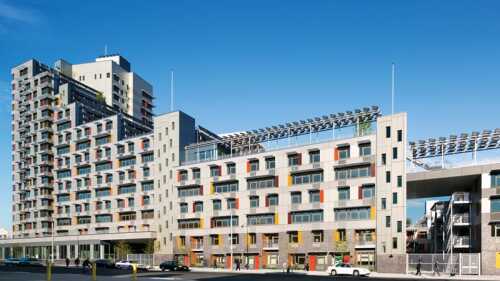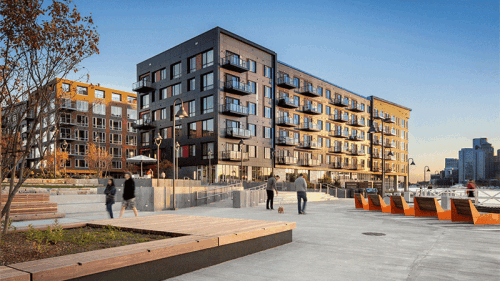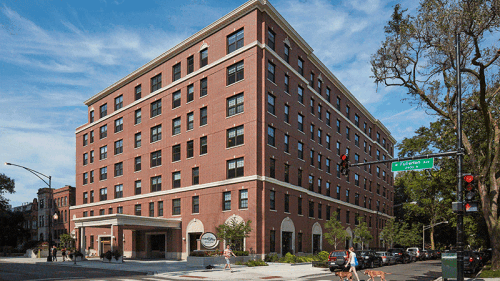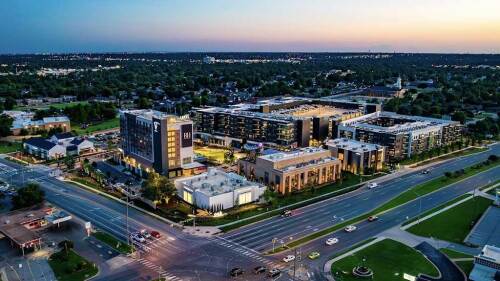Property Types
Hotels and Resorts
At a 2014 ULI Spring Meeting panel in Vancouver, three successful resort developers discussed how they are achieving success by focusing on health, wellness, and activities that bring together family members across all generations—even ex-spouses.
The redevelopment of the historic Metropole building represents the first full-service hotel to open in downtown Cincinnati in 28 years.
Perhaps nothing illustrates the precipitous fall of the U.S. resort sector as the saga that put a quartet of household-name properties under the control of a sovereign wealth fund.
Industrial
Extracting oil and natural gas from shale is just one driver of the state’s latest glory days.
Who would have thought that the revitalization of Detroit would include high-end watch manufacturing and the revival of a century-old shoe polish brand?
E-commerce has been the fastest-growing segment of the retail market for the last four years and can be expected to be a large share of the market for the next 15 to 20 years. Fulfillment centers have become the new face of industrial warehouse development, according to panelists at the ULI Fall Meeting in Chicago.
Mixed-Use
At the 2021 ULI Carolinas meeting, held as a virtual/in-person hybrid event in March, the annual Crane Watch session showcased projects under construction in North and South Carolina that use innovative planning and design in their placemaking efforts, creating iconic projects that help shape the neighborhoods that surround them. The projects this year included a historic storefront restoration, a shipping container–based food yard, and a massive nine-block development.
Through the new Yield Chicago program, seasoned and emerging development professionals are joining to share industry knowledge, networks, and best practices.
In a discussion of the ongoing transformation of U.S. retail, panelists participating in the 2020 ULI Spring Meeting Webinar Series agreed that the authenticity, differentiation, and transparency creating a sense of place in mixed-use retail spaces are likely to be what consumers seek in the future. Single-use spaces are about convenience, but that is only half of what consumers say they are looking for.
Multifamily
Multifamily experts gathered at the University of Southern California to highlight where denser construction is creating affordability.
With insights and research from a ULI Technical Advisory Panel and ULI’s Terwilliger Center, the Austin Housing Conservancy fund, a revolutionary approach to preserving workforce housing, was born. Now known as the Texas Housing Conservancy, the fund became the nation’s first to combine a nonprofit investment manager, Affordable Central Texas, with an open-end private equity fund.
At ULI Chicago’s October gathering at the new 73-story 1000M apartment tower, located at 1000 S. Michigan Ave., key members of the building’s development, architecture and construction teams hosted a tour of the project and enlightened attendees with a panel discussion on the history behind the skyscraper’s signature cantilever.
Office
Despite headwinds, debt funds continue to fill the void in commercial real estate financing.
Eight years ago, the landmark Paris Agreement kicked off a worldwide campaign to reduce carbon emissions. The targets set were big: slash emissions by 45 percent by 2030 and be net zero by 2050. So far, the world is not making enough progress on those lofty goals, and the progress that has been made has been very unevenly distributed. Experts from major real estate firms, including Boston Properties, CBRE, and Community Preservation Corporation, drove home the net zero transition’s importance during a panel discussion at the 2024 ULI Spring Meeting in New York City. They talked about the costs of getting to net zero, what lenders and owners are doing to get there, and the risk of not addressing climate change.
It’s tough to view a strong economy as bad news. Yet a firmly positive economic projection in ULI’s Real Estate Economic Forecast does not bode well for commercial real estate participants who are hoping for relief in rate cuts from the U.S. Federal Reserve.
Residental
The future of housing is being influenced by evolving demographics, increased urbanization, higher construction costs, and financially constrained consumers who nonetheless demand meaningful, walkable communities, said panelists at the 2020 ULI Housing Conference in Miami. A shower of innovation rains down on the housing designers and builders who sort through options that include prefabricated homes, modular building components, and low-carbon technologies that support sustainable development goals.
Out of the rising tides of climate change have emerged nimble projects that embrace rising floodwaters and shifts in thinking about design and construction, according to panelists at the 2020 ULI Housing Opportunity Conference in Miami.
With the population of older residents fast outpacing the supply of units designed for them, panelists at the 2020 ULI Housing Opportunity Conference in Miami shared how devolopers are working to address the misperceptions, changing financial considerations, and design trends for the sector.
Retail
The OAK project began in 2009, when a development firm set their sights on the corner of Northwest Expressway and North Pennsylvania Avenue, the state’s most important and busiest retail intersection. As the region’s only parcel capable of supporting a vertically integrated project of this scale and density, that land represented an opportunity to create something truly special.
As aging retail continue to evolve, one increasingly popular trend has been to redesign malls as town centers—recalling a time when such commercial districts were the heart and soul of a community. Mall–to–town center retrofits are emerging throughout the nation, especially in suburban communities, where pedestrian-friendly, mixed-use environments are highly attractive to millennials now raising families.
Consumers have kept a steady foot on the gas this year. A record-high 197 million consumers shopped in stores or online over the Thanksgiving holiday weekend, according to the National Retail Federation (NRF). The NRF forecasts that holiday sales will grow between 2.5 percent and 3.5 percent, with total retail spending in the United States falling between $979.5 billion and $989 billion during November and December. That forecast also is consistent with NRF’s annual U.S. sales growth—between 2.5 percent and 3.5 percent—for 2024.











![Western Plaza Improvements [1].jpg](https://cdn-ul.uli.org/dims4/default/15205ec/2147483647/strip/true/crop/1919x1078+0+0/resize/500x281!/quality/90/?url=https%3A%2F%2Fk2-prod-uli.s3.us-east-1.amazonaws.com%2Fbrightspot%2Fb4%2Ffa%2F5da7da1e442091ea01b5d8724354%2Fwestern-plaza-improvements-1.jpg)






